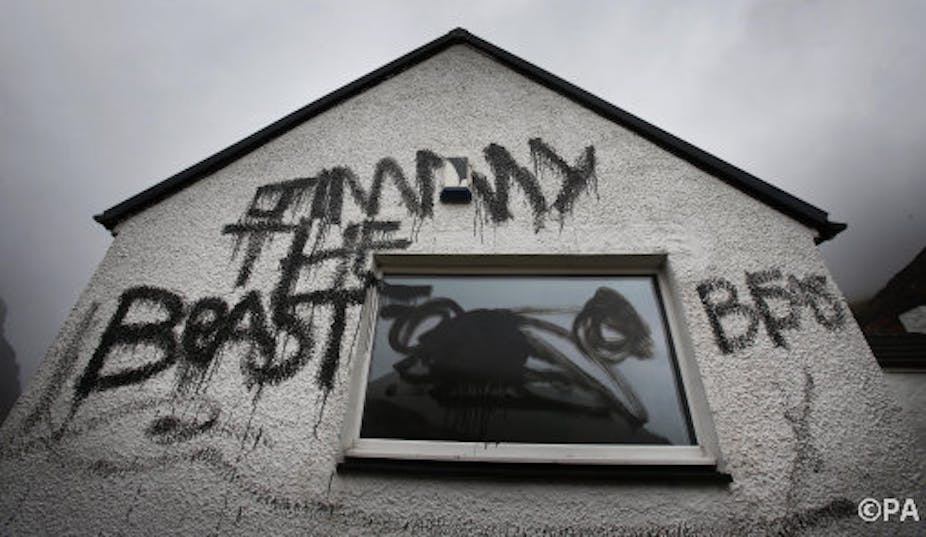The latest report on Jimmy Savile’s crimes in 28 NHS hospitals over the course of several decades have added more unspeakable allegations to the BBC DJ’s already unparalleled list of abuses.
Among them were his apparent abuse of 60 people aged five to 75 in just one hospital in Leeds, and the possibility that the former children’s television presenter may have interfered with dead bodies in a hospital morgue – all this thanks to essentially unlimited access to (and even accommodation at) various NHS institutions.
It’s clear that Savile was a prolific and dedicated sexual offender who can’t be pigeonholed as merely a paedophile, hebephilie, gerontophile or necrophile; his offending spanned all age, ethnic and gender divides. Savile was an opportunistic sex offender who played off his celebrity status, positive social perception and the access obtained by his charitable good works in order to manipulate the system and then go on to abuse countless individuals over his lifetime. The NSPCC places Savile’s victim count at at least 500, but it would hardly be surprising if it were higher.
Patterns of behaviour
What’s clear, especially from previously published police interviews, is that Savile was motivated by power and control, and seemed to revel in the complex abuse network that he had created. There are clear parallels between the way Savile operated and other high-prolife sexual abusers like Ian Waktins and Max Clifford. Saviles celebrity statusnand national presence gave the public the impression that they intimately knew him and therefore shoulf implicitly trust him; his celebrity status, in a sense, worked to protect him from reprisal.
In addition, Savile’s erratic personality traits and reputation as a slightly odd person were overridden by his high-profile charity work. The idea that he was a force for good meant people dismissed any behaviour or requests that would have set off alarm bells if they came from anyone else.
This in turn was cemented by very public friendships with establishment figures, which effectively meant Savile seemed “strange but acceptable”.
Things are very different now. The public’s understanding of sexual violence in the 1960s, 1970s and 1980s was nothing like as informed as it is today. The specialist police and professional training to deal sexual violence that we have come to rely on did not exist; the supervision and management of vulnerable populations (like the patients of Broadmoor) has changed enormously in the intervening decades.
This is not to say everything is perfect now – just that Savile’s crimes must be examined in context. That Savile was able to abuse for so long in such a widespread way reflects a lethal combination of his personal traits and the public and institutional culture of the time. It also flags up problems with our attitude to celebrity, and its potential consequences for the victims of the powerful.
Safeguarding
There is no particular reason to believe celebrities are any more or any less likely to be perpetrators of sexual violence than members of the public, at least in terms of their psychological makeup (although there is some evidence that celebrity is often linked with qualities such as narcissism). More importantly, celebrity status can mean transgressive behaviour (drug abuse, pathological promiscuity, minor offences) is more likely to be tolerated, or even facilitated.
One of the main questions which has arisen from the post-Savile rash of celebrity sexual abuse cases is the culpability of the police, who have appeared to have been complacent, complicit or absent at various crucial points over the decades. Both the Savile saga and the Ian Watkins case (among others) threw up evidence of poor police follow-up on reports of abuse or the suspicion of it.
In the Savile cases at least, this lack of follow-through can be partly explained by attitudes to sexual abuse at the time, but Savile’s celebrity status and accordant power and influence were the principal reasons the police failed to investigate him properly. Policing has changed and improved since then – but there are still serious problems.
The evidence against Watkins included numerous reports to the police over a lengthy period of time and a pattern of problematic online behaviour in open forums. The aftermath of the case has seen six officers served with gross misconduct notices and three police forces subject to IPCC investigation.
The contuining need for improvement
Since the 1960s, we have gotten much better at discussing sexual abuse. This does not mean that the message has got fully across, or that we have had maximum exposure, but it does mean sexual abuse is more visible than ever. More people are reporting it, and more and more historic cases are not only being reported but also followed up with a newfound tenacity.
But as a society, we need to do more work. We need to help people to understand and recognise sexual abuse, to understand perpetrators as well as victims, and to know who to approach for help.
And while the discussions of celebrity sexual abuse we’ve now embarked on are important conversations to have, they must also take stock of the wider role of celebrity in society – and the particular vulnerability of powerful abusers’ victims. Given the culture of celebrity we live with, we must confront the problem of how to respond to abuses of power and influence like Savile’s.
Above all, we need to avoid a simplistic, knee-jerk policy reaction, as we have seen in the past with sex offender disclosure. Instead, we need evidence-based policy that does more than just appeal to public outcry – however justifiable that outcry might be.

